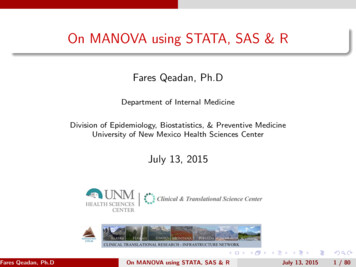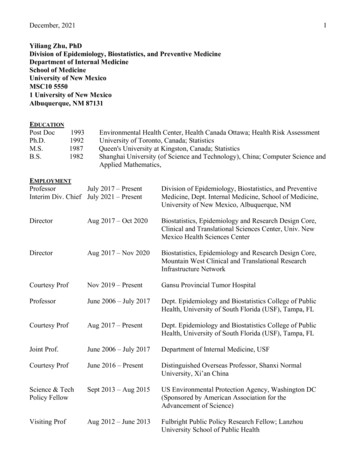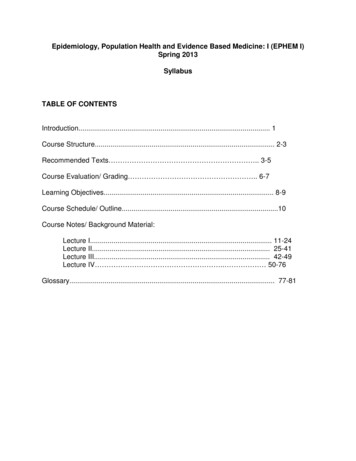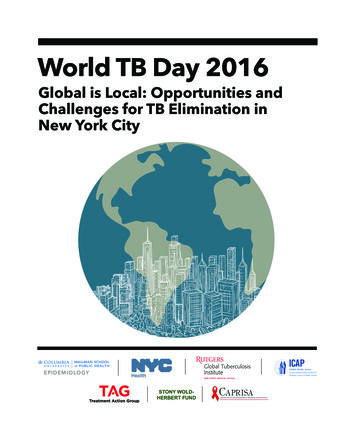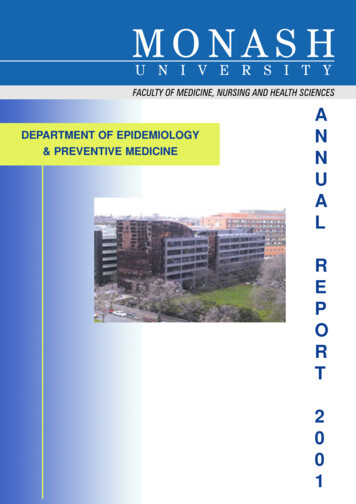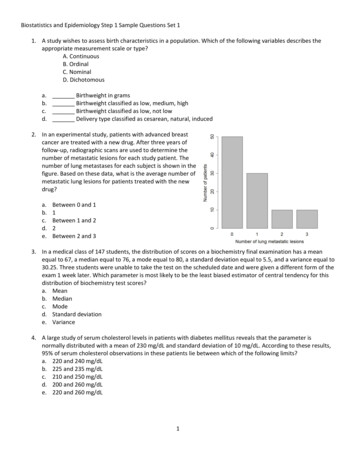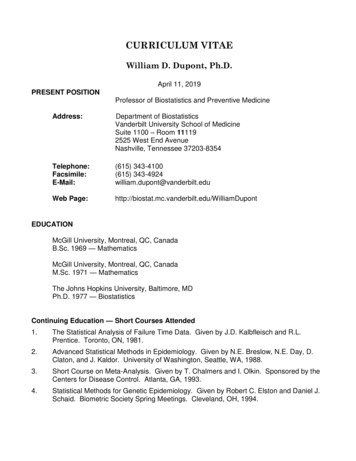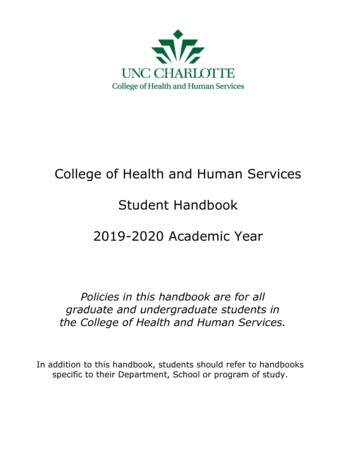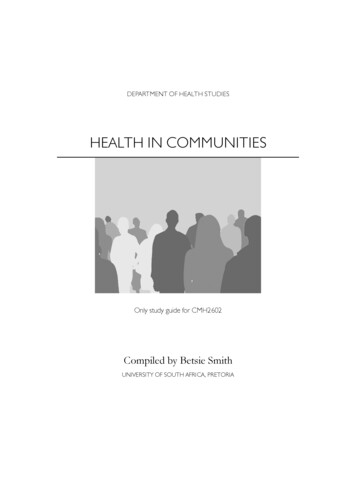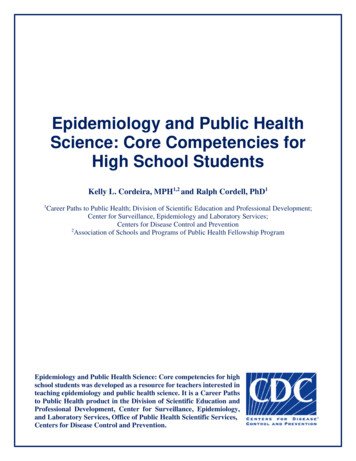
Transcription
Epidemiology and Public HealthScience: Core Competencies forHigh School StudentsKelly L. Cordeira, MPH1,2 and Ralph Cordell, PhD11Career Paths to Public Health; Division of Scientific Education and Professional Development;Center for Surveillance, Epidemiology and Laboratory Services;Centers for Disease Control and Prevention2Association of Schools and Programs of Public Health Fellowship ProgramEpidemiology and Public Health Science: Core competencies for highschool students was developed as a resource for teachers interested inteaching epidemiology and public health science. It is a Career Pathsto Public Health product in the Division of Scientific Education andProfessional Development, Center for Surveillance, Epidemiology,and Laboratory Services, Office of Public Health Scientific Services,Centers for Disease Control and Prevention.
AcknowledgementsWe appreciate the support of experts in both public health and education, including master teachers fromaround the United States, who have reviewed these competencies for content, classroom usability, andalignment with other educational resources. Their input has been ongoing and invaluable to thedevelopment of this product.Suggested citationCenters for Disease Control and Prevention (CDC). Epidemiology and Public Health Science: CoreCompetencies for High School Students. Atlanta, GA: US Department of Health and Human Services,CDC; 2015.Contact InformationPlease send questions and comments to scienceambassador@cdc.govDisclaimersThese core competencies for high school students are in the public domain and may be usedwithout restriction. Citation as to source, however, is appreciated.Links to nonfederal organizations are provided solely as a service to our users. These links donot constitute an endorsement of these organizations nor their programs by the Centers forDisease Control and Prevention (CDC) or the federal government, and none should beinferred. CDC is not responsible for the content contained at these sites. URL addresses listedwere current as of the date of publication.Use of trade names and commercial sources is for identification only and does not implyendorsement by the Division of Scientific Education and Professional Development, Centerfor Surveillance, Epidemiology, and Laboratory Services, Centers for Disease Control andPrevention, the Public Health Service, or the U.S. Department of Health and Human Services.The findings and conclusions in this document are those of the authors and do not necessarilyrepresent the official position of the 2Centers P a g e for Disease Control and Prevention.
Career Paths to Public HealthCareer Paths to Public Health’s (CPP) mission is to improve future workforce capacity by raising awareness,igniting interest, and developing competency in epidemiology and public health science (EPHS) amongsecondary school students as a means to increase health literacy and advance students into a public health careerpathway at an early age.Purpose of EPHS Core CompetenciesPublic health is among the fastest growing undergraduate fields in the nation.1 A growing interest in publichealth at the middle and high school levels has been noted.2-4 Secondary school curricula in public health areneeded to develop basic public health competencies and allow for a smooth transition to college-levelcoursework. Early experiences in the field may increase the likelihood of students pursuing a public healthcareer during later years.5,6 Substantial value in secondary school education in public health regardless of careerpath trajectories has also been reported. Public health education has the potential to expose students tocrosscutting public health concerns with immediate relevance. This supports development of knowledge andcritical thinking skills across public health domains and other disciplines, such as physical and natural sciences,social and behavioral sciences, mathematics and quantitative reasoning, and the humanities.3 Students will beexposed to concepts and experiences that support information and science literacy, ultimately leading to ainformed generation regarding public health.CPP developed EPHS core competencies to support high school teachers and administrators in creating EPHSbased curricula and proposals to accredit EPHS as an elective course in schools, districts, and states. Experts inboth public health and education, including master teachers from around the United States have reviewed thesecompetencies for content, usability in the classroom, and alignment with other educational resources.Organization of Core CompetenciesThe core competencies are based on four core public health domains (i.e., epidemiology, surveillance, analyticepidemiology, and prevention effectiveness), which provide the foundation for a humanities perspective (i.e., apublic health approach). Each domain has 3–4 core competencies supplemented with a clarification statement.The clarification statements provide content and skill information needed to meet each competency.Domains EPHS1: Epidemiologic Thinking and a Public Health Approach EPHS2: Public Health Surveillance EPHS3: Analytic Epidemiology EPHS4: Prevention Effectiveness1
Alignment of Core CompetenciesEPHS core competencies are based on the enduring understandings of epidemiology7, and align with NextGeneration Science Standards (NGSS) (http://www.nextgenscience.org/) *,8, and the Association of Schools andPrograms of Public Health (ASPPH) Recommended Critical Component Elements of an Undergraduate Majorin public health -baccalaureate-cce-report/).9 Theseassociations provide both vertical and horizontal connectivity and assure that these competencies provide afoundation for future studies and are firmly grounded in the discipline and pedagogy. (See Figure 1). Seeappendices for detailed alignment.Figure 1: Alignment of Epidemiology and Public Health Core Competencies for High School Students withNext Generation Science Standards*, Common Core, Enduring Understandings of Epidemiology, and ASPPHRecommended Critical Component Elements of an Undergraduate Major in Public Health.Source: Career Paths to Public Health, Centers for Disease Control and Prevention.*Next Generation Science Standards is a registered trademark of Achieve. Neither Achieve nor the lead states and partners thatdeveloped the Next Generation Science Standards was involved in the production of, and does not endorse this product.2
Enduring Understandings of EpidemiologyEPHS core competencies are based primarily on 12 fundamental or enduring epidemiologic understandingsdeveloped by Kaelin and coworkers.7 Twenty-eight judges for the Robert Wood Johnson Foundation and CollegeBoard’s Young Epidemiology Scholars (YES) Competition were surveyed and developed a consensusconcerning major concepts and principles around which epidemiology teachers at the high school level shouldstructure their curricula. These were further consolidated into four EPHS domains with 14 new corecompetencies that align with both NGSS (high school) and the ASPPH Recommended Critical ComponentElements of an Undergraduate Major in Public Health. See Appendix 1 for a detailed alignment of the enduringunderstandings of epidemiology with EPHS core competencies.Next Generation Science Standards* (High School)EPHS core competencies align with high school science and engineering practices and crosscutting conceptsused in NGSS. NGSS was developed on the basis of research from the National Research Council, AFramework for K-12 Science Education: Practices, Crosscutting Concepts, and Core Ideas10, and was publishedin 2013. These evidence-based standards propose a shift in teaching pedagogy from just learning about scienceto teaching students how to actually do science. Teachers can use these standards to engage students in criticalthinking concerning science by using discipline-specific core content, eight science and engineering practices(e.g., gathering, reasoning, and communicating) and seven crosscutting concepts (e.g., causality, patterns, andsystems).8 Practices and crosscutting concepts were considered in the development of EPHS core competencies.Each competency emphasizes 1–2 specific skills and ideas.In NGSS, core content was also identified for each discipline and includes performance expectations for eachcontent area. To align with NGSS, core content for EPHS was identified. The majority of content is based onPrinciples of Epidemiology in Public Health Practice11, a widely used CDC self-study program for thoseworking in public health. Ten content areas (e.g., epidemiologic thinking, surveillance, study designs, andintervention strategies) were identified and defined. These content areas and definitions were used to developthe clarification statements for each performance expectation. Alignment with NGSS in a similar visual formatand language is available in Appendix 2.ASPPH Critical Component Elements of an Undergraduate Major in Public HealthEPHS core competencies vertically align with the recommended critical component elements of anundergraduate major in public health. In 2012, ASPPH published key components by discipline, skill area,public health content area, and crosscutting areas.9 EPHS core competencies for high school students focus ondeveloping a necessary foundation to achieve standards at the undergraduate level. EPHS core competencies,overall, incorporate four ASPPH disciplines (i.e., science, social and behavioral sciences, mathematics andquantitative reasoning, and humanities and fine arts); two ASPPH skills areas (i.e., communication, informationliteracy); seven of nine ASPPH public health content areas with a focus on four (i.e., overview of public health,role and importance of data in public health, determinants of health, and health communication); and eightASPPH crosscutting areas with an emphasis on critical thinking and creativity, organizational dynamics,research methods, and systems thinking. Alignment with undergraduate critical components is available inAppendix 3.3
4
Epidemiology and Public Health Science (EPHS):Core Competencies for High School Students5
EPHS 1: Epidemiologic Thinking and a Public Health ApproachThis domain supports students’ understanding of the broad picture of epidemiology and public health science and how it influences health anddisease. Students can make connections among the causes of health and disease through epidemiologic thinking, and learn how a publichealth approach is used to improve health and prevent disease. The focus of this disciplinary core idea is concerning interdependencies ofepidemiology and public health action over time, while considering the historical evolution of epidemiology.HS-EPHS 1: Epidemiologic Thinking and a Public Health ApproachCompetencyClarification StatementHS-EPHS1-1 Describe how epidemiologic thinking is used toprovide an evidence-based explanationconcerning causes and correlations of health anddisease.Emphasis is on describing what basic epidemiology is, how it hasevolved and how it is used today, and the key methods and concepts ofepidemiology.HS-EPHS1-2 Discuss how epidemiologic thinking and a publichealth approach is used to transform a narrativeinto an evidence-based explanation.Emphasis is on examining scientific literature to identify coremethodology used and applied in different circumstances. Studentsexamine steps used in outbreak investigations and explain howcircumstances of an outbreak can dictate a different order be followed.HS-EPHS1-3 Apply epidemiologic thinking and a public healthapproach to a model (e.g., outbreak) to explaincause and effect associations that influence healthand disease.Emphasis is on how epidemiologic thinking and methods are tailoredto investigate specific health-related factors, provide evidence for theirinfluence, and propose public health interventions.6
EPHS2: Public Health SurveillanceThrough identifying patterns of health and disease and formulating hypotheses, students learn how to define health problems throughsurveillance, identify sources and methods for gathering data, and conduct descriptive epidemiology. By examining characteristics of healthand disease, including person, place, and time, students generate hypotheses and identify testable associations for study.HS-EPHS 2: Public Health SurveillanceCompetencyClarification StatementHS-EPHS2-1 Describe how to collect reliable data regardingpriority health-related phenomena using publichealth surveillance systems.Emphasis is on identifying priority health-related phenomenaaccording to importance of the problem; ability to prevent, control, ortreat the problem; and capacity of the health system to implementcontrol measures for the health problem. Also consider how data iscollected in determining which type of surveillance system (i.e., active,passive) is used.HS-EPHS2-2 Use credible evidence to describe a public healthsurveillance system.Emphasis is on describing a surveillance system and its attributes (e.g.,simplicity, flexibility, data quality, stability, acceptability, sensitivity,predictive value positive, representativeness, timeliness) qualitativelyand quantitatively.HS-EPHS2-3 Use models (e.g., mathematical models, andfigures) that are based on empirical evidence toidentify patterns of health and disease tocharacterize a public health problem.Emphasis is on identification of patterns using basic mathematicalmodels (e.g., frequency measures) and figures (e.g., epi curves, graphs,maps) to describe health-related occurrences by person, place, andtime.HS-EPHS2-4 Use patterns in empirical evidence to formulatehypotheses.Emphasis is on using descriptive epidemiology, what is knownconcerning health-related phenomena, and what others have postulatedin historical or current contexts to develop testable hypotheses.7
EPHS3: Analytic EpidemiologyStudents test hypotheses by making group comparisons and providing mathematical evidence for associations between exposure and disease.Then, students explain associations and judge causation on the basis of this evidence. Key aspects of analytic epidemiology, including studydesign, causality, and other explanations of evidence (e.g., bias, chance, confounding), are targeted. The performance expectations focus onidentifying appropriate study designs with considerations of the scope and limitations of each, conducting appropriate statistical testing toprovide mathematical evidence, and interpreting statistical results to determine public health influence.HS-EPHS 3: Analytic EpidemiologyCompetencyClarification StatementHS-EPHS3-1 Describe the capacity of basic epidemiologicEmphasis is on the time, order and processes for each study design,study designs (e.g., cross-sectional, case-control, appropriate design given the circumstances (including strengths andcohort, and randomized controlled trial) tolimitations), measure of effect, and role of the epidemiologist.address hypotheses under different circumstances.HS-EPHS3-2 Use empirical data from an experimental study(e.g., clinical trial) to mathematically quantify anassociation between an exposure and disease.Emphasis is on identifying the appropriate study design to produce thedesired data with the fewest number of limitations. Ability to measureassociation and public health affect should be considered.HS-EPHS3-3 Use empirical data from an observational study tomathematically quantify an association betweenan exposure and disease.Emphasis is on applying mathematical concepts (e.g., probability,statistics) to measure strength and significance of association betweenan exposure and outcome. Power, sample size, statistical tests, andability to determine associations should be considered. Examplecalculations can include measures of association (e.g. risk ratio,relative risk, odds ratio, and rate ratio) and measures of risk (e.g.,attack, incidence, prevalence, and mortality rates).HS-EPHS3-4 Make a statement concerning an associationbetween an exposure and disease withconsideration of a mathematical analysis ofempirical data.Emphasis is on interpreting statistical data to construct explanationsregarding strength and significance of an association between anexposure and outcome. Consideration of other explanations of evidence(e.g., bias, chance, and confounding) by other factors (e.g., social,economic, cultural, and environmental) must be made.HS-EPHS3-5 Make a statement concerning causality withconsideration of a mathematical analysis ofempirical data and Bradford Hill’s Criteria forCausality.12Emphasis is on applying probability and statistics to measure strengthand significance of association between an exposure and outcome.Consideration of Hill’s Criteria of Causation12 and of otherexplanations of evidence (e.g., bias, chance, and confounding) by otherfactors (e.g., social, economic, cultural, and environmental) must bemade.8
EPHS4: Prevention EffectivenessThe disciplinary core focuses on how the core sciences of public health can be transformed into action to improve health and prevent diseaseand how different metrics are used to determine effectiveness of those actions. Students consider the dynamic influences of other disciplinesconcerning public health prevention and control efforts. By identifying priorities, previous patterns of performance, and perspectives fromother disciplines, students learn how to systematically design public health policies, programs, and practices and assess their influence.HS-EPHS 4: Prevention EffectivenessCompetencyClarification StatementHS-EPHS4-1Describe a model illustrating how scientific,social, economic, environmental, cultural, andpolitical systems influence interventionperformance patterns.Emphasis is on identifying how ongoing changes in one or multiplesystems across disciplines can have variable effects on individual andsocietal health-related decisions to improve health and preventdisease.HS-EPHS4-2Use a targeted health promotion andcommunication approach (taking intoconsideration scientific knowledge, theorganization of systems and their performancepatterns, prioritized criteria, and tradeoffconsiderations) to design intervention strategies.Emphasis is on conducting research to determine if an intervention isplausible, applied research to determine if it can work, pilot projects toshow that it will work, and actual implementation to show that it doeswork.HS-EPHS4-3Evaluate competing health-related interventionstrategies by using a systematic assessment toimprove effectiveness.Emphasis is on program evaluation methods for planning,implementing, and assessing the effect of an intervention, andprevention effectiveness as a systematic assessment of influences ofpublic health policies, programs, and practices on health outcomes.9
Resources1. Leider JP, Castrucci BC, Plepys CM, et al. Characterizing the growth of the undergraduate publichealth major: U.S., 1992-2012. Public Health Rep. 2015;130(1):104-113.2. Stroup DF, Thacker SB. Epidemiology and education: using public health for teaching mathematicsand science. Public Health Rep. 2007;122(3):283-291.3. Holm-Delgado MG. Educating epidemiologists throughout the life course: moving fromconversation to action. Ann Epidemiol. 2014;24(3):169-170.4. Hlaing WM. "Educating epidemiologists" [letter]. Ann Epidemiol. 2014;24(7):558-559.5. Aschbacher PR, Lee E, Roth EJ. Is science me? High school students' identities, participation andaspirations in science, engineering, and medicine. J Res Sci Teach. 2010;47(5):564-582.6. Tai RH, Liu CQ, Maltese AV, Fan X. Career choice: Planning early for careers in science. Science.2006;312(5777):1143-1144.7. Kaelin MA, Huebner WW, Cordell RL, Szklarczuk B. Proessional development for prospectiveepidemiology teachers in grades 6-12. Public Health Rep. 2008;123(suppl 2):5-11.8. NGSS Lead States. Next Generation Science Standards: For States, By states. 2013. Available cience-standards. Accessed February 9, 2016.9. Association of Schools and Programs of Public Health. Recommended Critical Component Elementsof an Undergraduate Major in Public Health. 2012. Available at: http://www.aspph.org/wpcontent/uploads/2014/04/CCE 2012-08-03-FINAL.pdf. Accessed February 9, 2016.10. National Research Council. A Framework for K-12 Science Education: Practices, CrosscuttingConcepts, and Core Ideas. Washington, DC: National Academies Press; 2011.11. Centers for Disease Control and Prevention. Principles of Epidemiology in Public Health Practice,Third Edition: An Introduction to Applied Epidemiology and Biostatistics. 2006. Available 978.pdf. Accessed February 11, 2016.12. Hill AB. The environment and disease: Association or causation? Proc R Soc Med. 1965;58(5):295300.10
Appendices:Supplementary Documents11
12
Appendix 1: Alignment with Enduring Understandings of Epidemiology1Epidemiology and Public Health Science (EPHS): Core competencies for high school students primarilyare based on 12 fundamental or enduring epidemiologic understandings (EU) developed by Kaelin andcoworkers. These are statements summarize important ideas and core processes central to the discipline,have lasting value beyond the classroom, and represent major concepts and principles around whichteachers should structure their teaching. Twenty-eight judges for the Robert Wood Johnson Foundationand College Board’s Young Epidemiology Scholars Competition were surveyed and developed aconsensus regarding major concepts and principles around which epidemiology teachers at the highschool level should structure their curricula. This document represents a consolidation of these conceptsand into four EPHS domains with 15 new core competencies.Table 1: Alignment of CDC’s EPHS Core Competencies for High School Students with the EnduringUnderstandings of Epidemiology.CDC’s Epidemiology and PublicKaelin and coworkers1Health Science (EPHS) CoreEnduring Understanding(s) of EpidemiologyCompetencyHSDescribe how epidemiologicEU 1: The causes of health and disease areEPHS1-1 thinking is used to provide andiscoverable by systematically and rigorouslyevidence-based explanationidentifying their patterns among populations,concerning causes and correlations formulating causal hypotheses, and testing thoseof health and disease.hypotheses by making group comparisons. Thesemethods are at the core of the science ofepidemiology. Epidemiology is the basic science ofpublic health, a discipline responsible for improvinghealth and preventing disease among populations.HSDiscuss how epidemiologicEPHS1-2 thinking and a public healthapproach is used to transform anarrative into an evidence-basedexplanation.EU 12: An understanding of phenomena unrelated tohealth can be developed through epidemiologicthinking, by identifying their patterns in populations,formulating causal hypotheses, and testing thosehypotheses by making group comparisons.HSApply epidemiologic thinking andEPHS1-3 a public health approach to amodel (e.g., outbreak) to explaincause and effect associations thatinfluence health and disease.EU 1: The causes of health and disease arediscoverable by systematically and rigorouslyidentifying their patterns among populations,formulating causal hypotheses, and testing thosehypotheses by making group comparisons. Thesemethods are at the core of the science ofepidemiology. Epidemiology is the basic science ofpublic health, a discipline responsible for improvinghealth and preventing disease among populations.13
Table 1, con’t.CDC’s Epidemiology and PublicHealth Science (EPHS) CoreCompetencyHSDescribe how to collect reliableEPHS2-1 data regarding priority healthrelated phenomena by usingpublic health surveillance systems.Kaelin and coworkers1Enduring Understanding(s) of EpidemiologyEU 2: Health and disease are not distributedhaphazardly among a population. Patterns to theiroccurrence are discernable. These patterns can beidentified through the surveillance of populations.HSUse credible evidence to describeEPHS2-2 a public health surveillancesystem.EU 2: Health and disease are not distributedhaphazardly among a population. Patterns to theiroccurrence are discernable. These patterns can beidentified through the surveillance of populations.HSUse models (e.g., mathematicalEPHS2-3 models or figures) that are basedon empirical evidence to identifypatterns of health and disease tocharacterize a public healthproblem.EU 2: Health and disease are not distributedhaphazardly among a population. Patterns to theiroccurrence are discernable. These patterns can beidentified through the surveillance of populations.HSUse patterns in empirical evidenceEPHS2-4 to formulate hypotheses.EU 3: Analysis of these patterns of health anddisease can help formulate hypotheses regardingtheir possible causes.HSDescribe the capacity of basicEPHS3-1 epidemiologic study designs (e.g.,cross-sectional, case-control,cohort, and randomized controlledtrial) to address hypotheses underdifferent circumstances.EU 4: A hypothesis can be tested by comparing thefrequency of disease in selected groups of peoplewith and without an exposure to determine if theexposure and the disease are associated.HSUse empirical data from anEPHS3-2 experimental study (e.g., clinicaltrial) to mathematically quantifyan association between anexposure and disease.EU 6: When an exposure is hypothesized to have abeneficial effect, studies can be designed in which agroup of people is intentionally exposed to thehypothesized cause and compared with a group whois not exposed.HSUse empirical data from anEPHS3-3 observational study tomathematically quantify anassociation between an exposureand disease.EU 4: A hypothesis can be tested by comparing thefrequency of disease in selected groups of peoplewith and without an exposure to determine if theexposure and the disease are associated.EU 5: When an exposure is hypothesized to have adetrimental effect, it is unethical to intentionallyexpose a group of persons. In these circumstances,studies can be designed that observe groups of freeliving people with and without the exposure.14
Table 1, con’t.CDC’s Epidemiology and PublicHealth Science (EPHS) CoreCompetencyHSMake a statement concerning anEPHS3-4 association between an exposureand disease with consideration ofa mathematical analysis ofempirical data.HSMake a statement concerningEPHS3-5 causality with consideration of amathematical analysis of empiricaldata and Bradford Hill’s Criteriafor Causality.Kaelin and coworkers1Enduring Understanding(s) of EpidemiologyEU 7: One possible explanation for finding anassociation is that the exposure causes the outcome.Because studies are complicated by factors notcontrolled by the observer, other explanations alsomust be considered, including chance, bias,confounding, and reverse time order.EU 8: While a given exposure might be necessary tocause an outcome, the presence of a single factor isseldom sufficient. The majority of outcomes arecaused by a combination of exposures that caninclude genetic make-up, behaviors, social,economic, and cultural factors and the environment.EU 9: Judgment regarding whether an exposurecauses a disease is developed by examining a bodyof epidemiologic evidence as well as evidence fromother scientific disciplines.HSDescribe a model illustrating howEPHS4-1 scientific, social, economic,environmental, cultural, andpolitical systems influenceintervention performance patterns.EU 10: Individual and societal decisions regardingwhat should be done to improve health and preventdisease are based on more than scientific evidence.Social, economic, ethical, environmental, cultural, orpolitical factors are also considered in decisionmaking.HSUse a targeted health promotionEPHS4-2 and communication approach(taking into considerationscientific knowledge, theorganization of systems and theirperformance patterns, prioritizedcriteria, and tradeoffconsiderations) to designintervention strategies.EU 10: Individual and societal decisions regardingwhat should be done to improve health and preventdisease are based on more than scientific evidence.Social, economic, ethical, environmental, cultural, orpolitical factors are also considered in decisionmaking.HSEvaluate competing health-relatedEPHS4-3 intervention strategies by using asystematic assessment to improveeffectiveness.EU 11: The effectiveness of a health-promotingstrategy can be evaluated by comparing thefrequency of disease among selected groups ofperosns who were and were not exposed to thestrategy. Costs, trade-offs, and alternative solutionsmust also be considered in evaluating the strategy.Resource for Appendix 11. Kaelin MA, Huebner WW, Cordell RL, Szklarczuk B. Proessional development for prospectiveepidemiology teachers in grades 6-12. Public Health Rep. 2008;123(suppl 2):5-1115
16
Appendix 2: Alignment with the Next Generation Science Standards *,1Epidemiology and Public Health Science (EPHS): Core competencies for high school students alignwith the Next Generation Science Standards (NGSS) by incorporating three dimensions, includingcontent, practices, and crosscutting concepts within each EPHS domain (i.e., disciplinary core area). TheNational Research Council’s (NRC) framework for K-12 Science education describes these dimensionsin detail, emphasizing that proficiency in science is learned though examination of evidence and itscontext, the development of models and theories, and the ongoing revision of knowledge derived fromthese methods of science.2CDC Epidemiology and Public Health Science Disciplinary Core ContentCPP identified EPHS disciplinary core content. To teach public health at the high school level, themajority of content was derived from Principles of Epidemiology in Public Health Practice, ThirdEdition3, a CDC document developed as an introductory course for public health professionals, andtailored f
NGSS was developed on the basis of research from the National Research Council, A Framework for K-12 Science Education: Practices, Crosscutting Concepts, and Core Ideas 10, and was published in 2013. These evidence-based standards propose a shift in teaching pedagogy from just learning about science to teach
